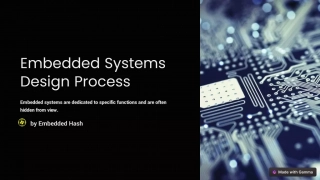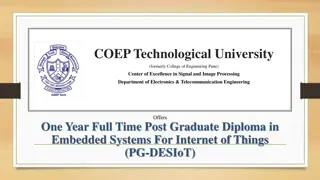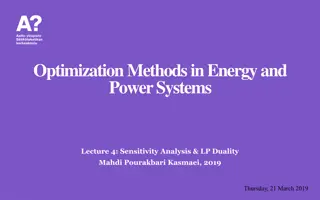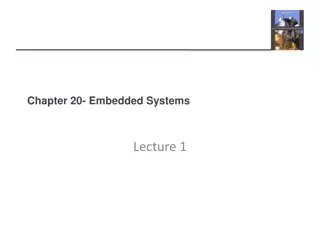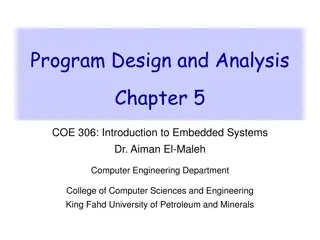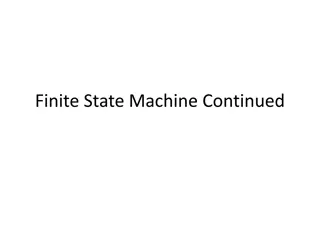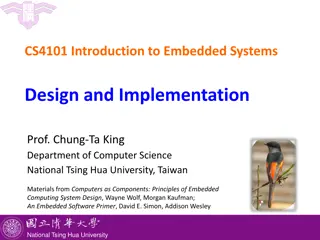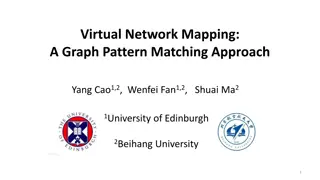Practical Implementation of Embedded Shadow Page Tables for Cross-ISA System Virtual Machines
This research focuses on the practical implementation and efficient management of embedded shadow page tables for cross-ISA system virtual machines. It discusses the framework, evaluation, and conclusions regarding system virtualization, particularly addressing memory virtualization overhead and optimizations for enhancing performance. The study explores the significance of cross-ISA virtualization in allowing applications to run across different instruction-set architectures seamlessly and its relevance in cloud computing and software development.
- Embedded Shadow Page Tables
- System Virtualization
- Cross-ISA
- Memory Virtualization
- Performance Optimization
Download Presentation

Please find below an Image/Link to download the presentation.
The content on the website is provided AS IS for your information and personal use only. It may not be sold, licensed, or shared on other websites without obtaining consent from the author. Download presentation by click this link. If you encounter any issues during the download, it is possible that the publisher has removed the file from their server.
E N D
Presentation Transcript
HSPT: Practical Implementation and Efficient Management of Embedded Shadow Page Tables for Cross-ISA System Virtual Machines Zhe Wang1, Jianjun Li1, Chenggang Wu1 , Dongyan Yang2, Zhenjiang Wang1, Wei-Chung Hsu3, Bin Li4, Yong Guan5 1State Key Laboratory of Computer Architecture, Institute of Computing Technology, 2China Systems and Technology Lab, IBM, 3Dept. Computer Science & Information Engineering, National Taiwan University, 4Netease, 5College of information Engineering, Capital Normal University Institute of Computing Technology Chinese Academy of Sciences 1
Outline Background Motivation Contributions The Framework of HSPT Evaluation Conclusion Institute of Computing Technology Chinese Academy of Sciences 2
Outline Background Motivation Contributions The Framework of HSPT Evaluation Conclusion Institute of Computing Technology Chinese Academy of Sciences 3
System Virtualization System virtualization has regained its popularity in recent years and has been widely used for cloud computing. Allow applications running on such systems to be agnostic about the underlying operating systems and hardware platforms. Enable developing and testing OS and application on different platforms. e.g. Android Emulator on a PC (ARM to x64) App App OS OS Hypervisor Institute of Computing Technology Chinese Academy of Sciences 4
The Category of System Virtualization System virtualization can be divided into same-ISA and cross-ISA categories depending on whether the guest and the host are of different instruction-set architecture. Same-ISA system virtualization is commonly used for server consolidation. Example: VMware Workstation, VirtualBox. virtualization. We only focus on Cross-ISA system Cross-ISA system virtualization is also important and commonplace. Android Emulator emulates the Android/ARM environment on the x86-64 platforms is yet another example, it offers great conveni- ence in development and debugging to Android application deve- lopers. Institute of Computing Technology Chinese Academy of Sciences 5
The Overhead of Cross-ISA System Virt. Virtualization brings an additional layer of abstraction and causes some unavoidable overhead. Memory virtualization overhead is one major overhead. Memory subsystem emulation in QEMU system mode takes about 23%~43% time during the execution. [ESPT, VEE 14] All hardware functions are emulated by software. So optimizations to minimize such memory virtualization overhead are the key to enhance the performance of the Cross-ISA system-level emulator. Institute of Computing Technology Chinese Academy of Sciences 6
Traditional Memory Virtualization in Cross-ISA Guest OS 0 4G guest virtual address (GVA) P 1 Memory Mapping Table Page Entry (GPA->HVA) Address translation Guest Page Table 2 1 SGPS: Simulated Guest Physical Space Page Entry (GVA->GPA) 0 1G guest physical address (GPA) P 2 P N Address Page 264-1 0 host virtual address (HVA) SGPSP 3 Host Page Table 3 Emulator Page Entry (HVA- >HPA) 0 4G host physical address (HPA) P 4 Host OS Disadvantage Each guest memory access instruction will go through these three address translations. Despite of software-TLB, the overhead is still huge. Host OS Institute of Computing Technology Chinese Academy of Sciences 7
Embedded Shadow Page Table Embedded Shadow Page Tables (ESPTs) has been propo- sed to reduce address translations and improve the perf- ormance.[ESPT, VEE 14] ESPT utilizes the larger address space on modern 64-bit processors and creates a loadable kernel module (LKM) to embed the shadow page entries into the host page ta- ble. Those shadow page table (SPT) entries are used to store the mapping between guest virtual address and host ph- ysical address. This table can be used by the hardware walker. Institute of Computing Technology Chinese Academy of Sciences 8
Embedded Shadow Page Table (cont.) Guest OS 0 4G SGPS: Simulated Guest Physical Space guest virtual address (GVA) P 1 Address Mapping GDVAS: Guest Dedicated Virtual Address Space 0 1G 1 guest physical address (GPA) P 2 Address translation 264-1 0 4G host virtual address (HVA) G 1 SGPSP GDVAS 3 Host Page Table Embedded Shadow Page Entry 2 Shadow Page Table 0 4G host physical address (HPA) P 4 Emulator Page Entry Host OS Hardware can walk the shadow page table directly to accelerate guest memory access. ESPT uses LKMs to create shadow page mapping (mapped G1 to P4). It also proposed a signal notification mechanism to reduce overhead of creating shadow page mapping. It intercepted the TLB flush instruction to reduce synchronization overhead. Institute of Computing Technology Chinese Academy of Sciences 9
Embedded Shadow Page Table (cont.) Support for Multi-Process ESPT maintains a shadow page table for each guest process, when the guest process switches, ESPT will use LKMs to set the host directory page table base pointer for the lower 4G space to the targeted shadow page table. Shadow Page Table A Guest Process Switching Host Page Table Embedded Shadow Page Entry Switch Process A to Process B Switch Process B to Process N Shadow Page Table B ... Emulator Page Entry Shadow Page Table N Institute of Computing Technology Chinese Academy of Sciences 10
Outline Background Motivation Contributions The Framework of HSPT Evaluation Conclusion Institute of Computing Technology Chinese Academy of Sciences 11
Motivation ESPT can significantly reduce the address translation over head. However, ESPT has a few drawbacks due to LKM. Using LKMs is less desirable for system virtual machines due to portability, security and maintainability concerns. Most of LKMs use the internal kernel interface and different kernel versions may have different interfaces. To enforce security, modern OS only allows the user who has root privilege to load LKMs. Using LKMs, the kernel would be less secure. For example, for the Linux kernel, many kernel exploits have been reported, and often these exploits attack LKMs instead of the core kernel [APSys 11]. So we proposed a different implementation to manage ESPTs without using LKMs. Institute of Computing Technology Chinese Academy of Sciences 12
Outline Background Motivation Contributions The Framework of HSPT Evaluation Conclusion Institute of Computing Technology Chinese Academy of Sciences 13
Contributions Proposed a practical implementation of ESPT without using loadable kernel modules. Proposed an efficient synchronization mechanism based on shared memory mapping methods. Proposed and evaluated three SPT organizations. Our approach has achieved up to 92% speedup for CINT 2006 benchmarks and 44% improvement for the Android system boot and practical applications start-up on the Android emulator. Institute of Computing Technology Chinese Academy of Sciences 14
Outline Background Motivation Contributions The Framework of HSPT Evaluation Conclusion Institute of Computing Technology Chinese Academy of Sciences 15
Challenges of ESPT without using LKMs ESPT only uses a LKM to help to complete two operations. Creating shadow page mapping. Because shadow page table should be walked by hardware MMU directly, so it must be placed in host kernel space and at kernel privilege. Handling guest multi-process. By modifying the host page table, ESPT complete switching shadow page table. Our challenges are how to complete these two operations without using LKMs. To distinguish our new implementation from the original ESPT, we call our approach Hosted Shadow Page Table (HSPT). Institute of Computing Technology Chinese Academy of Sciences 16
Challenge1: Creating Shadow Page Mapping ? Tradtional address translation: . HSPT: What we need to do is to make G1 to share P4 mapped from P3. So we use shared memory mechanism which maps two or more virtual pages to the same physical page to accomplish this shared operation ( mmap system call). operation. guest virtual address (GVA) P1->P2->P3->P4 P1->G1 P4 0 4G SGPS: Simulated Guest Physical Space P 1 GDVAS: Guest Dedicated Virtual Address Space 0 1G guest physical address (GPA) P 2 MAP_SHARED 264-1 0 4G host virtual address (HVA) G 1 SGPSP GDVAS 3 Host Page Table Hosted Shadow Page Entry offset F 1 File 0 4G host physical address (HPA) P 4 offset Emulator Page Entry Host OS Institute of Computing Technology Chinese Academy of Sciences 17
Creating Shadow Page Mapping The time of creating shadow page mapping (similar to ESPT). We do not create mappings for all SPT entries. Instead, we only set the page protection value of all the entries. Thus when a shadow page entry is accessed at the first time, the SIGSEGV will be raised and we have the chance to create the mapping. We also intercept the guest TLB flush instruction to monitor the modifications of guest page table and update the SPT (similar to ESPT). Institute of Computing Technology Chinese Academy of Sciences 18
Challenge2: Handling Guest Multi-process By using LKM, ESPT can easily switch the corresponding shadow page table (SPT) when guest switch the process by modifying the host page table. So the different SPT can use the same host virtual address. Without using LKM, different shadow page table must use different host virtual space (each SPT is bound to a separate GDVAS). So we investigate three variations of SPT organizations. Shared SPT All guest processes shared the same shadow page table. Private SPT Each guest process has its own shadow page table. Group Shared SPT It is a combination of the Shared SPT and the Private SPT. Institute of Computing Technology Chinese Academy of Sciences 19
Shared SPT All guest processes shared the same shadow page table. Process A execute routine 1. First time access page P1 2. Receive SIGSEGV,create G1 mapping 2 A to B Process B execute routine Time 1 switch 3. First time access page P2 4. Receive SIGSEGV,create G1 mapping 5 4 switch B to A 5. Access page P1 6. Receive SIGSEGV, create G1 mapping 7 0 4G 0 4G P 1 P 2 Process A Process B GVA Host User Space Host Kernel Space G 1 GDVAS HVA 0 base base+4G 264-1 3 6 Empty shadow page table by mmap GDVAS with none prot Institute of Computing Technology Chinese Academy of Sciences 20
Private SPT In the Shared SPT strategy, when a process is switched back again, the information of the filled SPT entries in the last timeslot is lost and the SPT of the switched-in process has to be warmed up again. So each guest process has its own shadow page table is a good solution. But there is a problem that how to monitor the switched- out guest page tables (GPTs). Setting write-protection to the switched-out GPTs is a common but expensive method. Institute of Computing Technology Chinese Academy of Sciences 21
Private SPT (cont.) Consider x86 and ARM, as an example, they use PCID (Process Context Identifier) and ASID (Address Space Identifier) respectively to identify TLB entries for each pr- ocess. We call this kind of identifier as Context Identifier (CID). When guest modifies the switched-out process s page table, TLB must be informed with CID and the address. Base on this principle, we choose to bind each SPT with a CID rather than the process ID. Institute of Computing Technology Chinese Academy of Sciences 22
Private SPT (cont.) 0 4G 0 4G 0 4G 0 4G Process 2 GVA Process 0 Process 1 Process Guest OS manage CID Point to current CID CID Table0 1 A B N-1 Context Identifier Host User Space Host Kernel Space Base_A Base_B 0 264-1 Host Page Table HVA GDVAS_B GDVAS_A SPT_B The number of GDVAS is N SPT_A Guest os switch CID A to CID B (process switching) gs segment register is used to store current base of GDVAS. X64 Instruction ARM Instruction Segment Register gs: Base_A Base_B ldr R0, [fp] mov gs:esi, eax translate Institute of Computing Technology Chinese Academy of Sciences 23
Group Shared SPT Private SPT consumes too much host virtual space. Taking ARM as the guest, a virtual space size of 256*4G=1TB (upto 256 different processes allowed) would be needed. 0 4G Process 1 4G 0 4G 0 Process .. Process 0 GVA CID Table0 1 A B N-1 GDVAS Pool Manager (use LRU Algorithm) M<=N Host User Space Host Kernel Space GDVAS Table 0 M-1 GDVAS_0 HVA GDVAS_M-1 0 Base_M-1 Base_0 264-1 The number of GDVAS is M Institute of Computing Technology Chinese Academy of Sciences 24
Group Shared SPT (cont.) With a given number of SPTs, if the number of processes is relatively small, each process can obtain its own SPT, thus enjoy the full benefit of Private SPT. When the number of processes increases beyond the nu- mber of SPTs, some processes must share a SPT. So Group Shared SPT works adaptively to balance betw- een high performance and limited virtual address space. Institute of Computing Technology Chinese Academy of Sciences 25
Outline Background Motivation Contributions The Framework of HSPT Evaluation Conclusion Institute of Computing Technology Chinese Academy of Sciences 26
Experiment Setting Experiment platform Host Machine: Intel E74807 machine with 1064MHZ, 15G RAM Host OS: Ubuntu 12.04.3 LTS(x86-64). Guest OS: Android 4.4 (Linux Kernel: 3.4.0-gd853d22nnk, ARM) Bechmark SPEC CINT2006 Comparison Tradtional Memory Virtualization Hosted Shadow Page Table Shared SPT Private SPT Group Shared SPT Institute of Computing Technology Chinese Academy of Sciences 27
Shared SPT/Private SPT Shared SPT has one SPT. Private SPT has 256 SPTs. Institute of Computing Technology Chinese Academy of Sciences 28
Group Shared SPT We test the performance when the number of SPTs is 1, 4, 8, 16 and 32. We can see obviously the performance keeps improving with the increasing number of SPTs and when the number of SPTs exceeds 8, the performance of Group Shared SPT is very close to Private SPT. Institute of Computing Technology Chinese Academy of Sciences 29
Disscussion We did not compare the performance of HSPT side-by-side with ESPT. Our work does not claim HSPT will yield greater performan ce than ESPT. It is motivated for better platform portability, higher system security, and improved usability for application developers since non-root users can also benefit from HSPT technology. Institute of Computing Technology Chinese Academy of Sciences 30
Outline Background Motivation Contributions The Framework of HSPT Evaluation Conclusion Institute of Computing Technology Chinese Academy of Sciences 31
Conclusion We proposed an practical implementation of SPT for cross -ISA virtual machines without using LKMs. Our approach uses part of the host page table as SPT and rely on the shared memory mapping schemes to update SPT, thus avoid the use of LKMs. We Proposed and evaluated three SPT organizations to handle multi-processing in guest OS. With sufficient host virtual space, our approach has achieved up to 92% speedup for CINT2006 benchmarks. Institute of Computing Technology Chinese Academy of Sciences 32
Thank You Institute of Computing Technology Chinese Academy of Sciences 33


